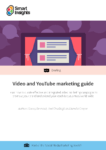If you're receptive to feedback and create a product that your audience really wants, you’re guaranteed to develop something worthy of the "premium" label
Industry leaders like to lob around the term "premium" when describing content, but the definition of what is premium - and what isn’t - is highly subjective.
To quote Inigo Montoya: "You keep using that word. I do not think it means what you think it means."
For some people, "premium" denotes high-quality content. For some, it might refer to their most popular content and for others, it means something else entirely.
Part of this confusion stems from the numerous business models that attempt to capitalize on differing versions of premium content.
Download our Premium Resource – Video and YouTube marketing guide
Our guide shows you how to review the full opportunities from video marketing whether you are a company looking to integrate video marketing more into your campaigns or a marketing agency looking to improve your video marketing services.
Access the Video and YouTube marketing guide
There's advertising video on demand (AVOD), which audience members indirectly pay for via their attention. When you watch a viral video to see whether fast food is as good as a gourmet sandwich, for instance, you pay for that premium content by watching a short advertisement. You can find this sort of content on YouTube or Hulu.
There's also subscription video on demand (SVOD), for which subscribers pay a flat fee to have access to a large video library. Netflix, Amazon Prime Video and Rooster Teeth are examples of this model. Subscribers either pay a premium to access unlimited material, or they might be able to access a limited amount of content via a freemium subscription.
Finally, transactional video on demand (TVOD) offers users the chance to rent or buy individual videos or a series. Unlike SVOD, users can only access the content they have purchased. Apple’s iTunes store, Vudu and Google Play all employ this model to some extent.

Each of these methods of deriving revenue from content is different, but there is one common thread: Premium is in the eye of the beholder. If a customer or viewer is willing to pay for something, it is premium to that person. When viewers vote for one product with their limited dollars (or time) instead of another product, they are declaring it premium.
Changing the Definition of Premium
With the explosion in media in the past two decades, the assumptions around what qualifies as premium content (and what doesn't) have changed. In the past, a small number of media outlets were able to decide what content the masses would have to pay to access.
Audiences either chose to watch what those companies produced or chose not to watch anything at all. You could either fork over your hard-earned cash to see the latest and greatest from the likes of HBO and MTV, or you could settle for the programming that your local affiliates offered on the air.
That’s no longer the case. The number of companies and individual people producing content has grown exponentially and premium content is no longer dictated by a handful of companies. In this new reality, audiences are the ones defining premium content. This power transfer has significant repercussions for members of the media world.
It’s no longer enough to slap something together and use marketing to manipulate people into viewing it as premium. We must ditch this relic of a model and instead listen to how our audiences identify what they value. Beyond their likes and dislikes, we want a decent idea of what experiences inspire their active support. YouTube is doing this through its YouTube Premium subscription, for example, which provides access to YouTube Originals.
Producers also make the mistake of not trying to create premium content in the first place, instead favoring fast and dirty content that chases trends. This might yield views and shares in the short term, but these alone cannot sustain the development of brands that will become fixtures in our lives. This approach also fails to inspire loyalty or recognition from consumers, who have no problem paying a premium for products or experiences that give them value and meaning.
Creating Premium Content
While every person has a different definition of premium, there are overarching themes that can ensure anyone is able to find value in your content. Here are four ways to create content that feels universally premium:
1. Solve a problem by satisfying a need
Start by identifying what sort of content isn’t readily available elsewhere. You might create provocative social commentary, or you might create startlingly original entertainment. "Comedians in Cars Getting Coffee" is a great example of an original concept that morphed into premium content.

Regardless of your strategy, you can only expect viewers to pay for your content if it satisfies a need that they can’t satisfy elsewhere for free. If you aren’t filling a gap, don’t expect a crowd to flock to your creations.
2. Develop a unique editorial vision
To create premium content that viewers can't find elsewhere, you must develop your own brand. Each piece of content should fit within the identity and vision of your brand.
The New York Times has long embraced the motto of "All the News That’s Fit to Print." Over the decades, the newspaper has developed a reputation for its unique brand of high-quality journalism. There’s a reason The New York Times is able to charge a premium for its online content when other media outlets can't.
3. Consistently engage with your audience
Remember that your audience members are the ones driving your premium content. If the audience doesn’t like what you offer, those people are more than happy to get their content elsewhere.
Fortunately, it’s easier than ever to engage with people. Viewers will let you know what they think via comments on your YouTube channel or conversations and retweets on Twitter. Deliberately solicit that feedback and then adjust or refine your content accordingly to satisfy your audience’s expectations.
We did this with "Fear Pong," our video series that has racked up millions of views. We’ve engaged in a consistent conversation with our audience about their visions for "Fear Pong," which helped us create a better product.
4. Try lots of content
You never quite know how your audience is going to react to new content. Experimentation is necessary and you’re bound to fall flat on your face at some point. Sir James Dyson of vacuum fame built 5,126 prototypes before he finally found success with a design.
Just remember that one of your quirky or seemingly ridiculous ideas might be the one that achieves wild success. Be comfortable knowing that you will need to try a lot of different approaches before you strike gold. After plenty of trial and error, you’re certain to find something your audience is willing to buy.
Final thoughts
While you develop your own strategy for premium content, it might feel like there is far too much competition in the marketplace. While it’s true that content has never been more widely available, premium content is still premium content.
If you identify and produce a product that your audience wants - and adjust course based on feedback - you’re guaranteed to eventually find something worthy of the "premium" label. When your content is truly filling a need, audiences are more than happy to pay.
Christopher Rudy is a co-founder and chief strategy officer of
Cut, a next-generation media company that fuels fandom and deep engagement. With more than 10 million subscribers across
YouTube,
Facebook, and Snapchat driving about 300 million views a month, Cut’s work challenges and determines the zeitgeist for digital video.









